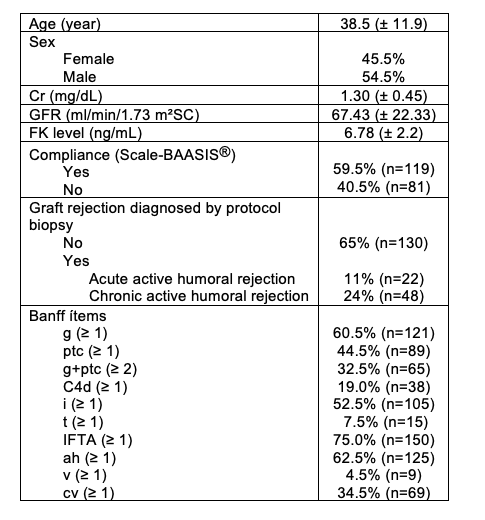
Hyalinosis lesions in kidney protocol biopsies´s association with adherence to immunosuppressive medication measured using the BAASIS scale in a kidney transplant mexican population
Lucino Bahena Carrera1, Carlos Adrián Chávez Mendoza1, Rocío Estéfany López Sánchez1, Luis Ignacio Manzo Arellano1, Cielo Patricia Muñoz Olvera1, Martín Fuentes Durán1, Martha Santiago Torres1, Héctor Faustino Noyola Villalobos1.
1Nephrology and Transplant, Central Military Hospital, Mexico City, , Mexico
Introduction: Non-adherence to immunosuppressive treatment after renal transplantation is a major cause of graft failure. It is unknown whether the histology in protocol renal biopsies in non-adherent renal transplant patients differs from that adherent patients.
Among strategies to evaluate adherence to immunosuppression are adherence tests. The Basel Assessment of Adherence with Immunosuppressive Medication Scale-BAASIS® was used, validated in spanish language for use in kidney transplant patients. Cardoso BD reported non-adherence in 72% of brazilian kidney transplants.
Einecke G mentions that ah Banff scores remain less than 1 until approximately 500 days post-transplant.
Method: Observational, analytical, transversal and prospective study from January 2018 to February 2023. Were included all G5 KDIGO chronic kidney patients who were transplanted at Central Military Hospital, Mexico. When patients were 3 years post-transplant, they underwent renal biopsy protocol, which was histologically analyzed using the Banff score and at the same time the Scale-BAASIS® was applied. The Kolmogorov-Smirnov test was performed to determine the normality of the variables, analytical statistics were performed with Xi²and Mann-Whitney tests; p< 0.05 was statistically significant.
Results: Were included 200 kidney transplant recipients. Using Scale-BAASIS®, non-compliance prevalence 3 years post-transplant was 40.5%. There weren´t subtherapeutic tacrolimus levels.

Subclinical humoral rejection (acute or chronic) was diagnosed in 35% of the patients, microvascular inflammation in 32.7%.

There wasn´t correlation between microvascular inflammation or calcineurinic toxicity with the dichotomous variable of adherence, but when performing a sub-analysis comparing adherence vs. BAASIS score ≥2, these were the Banff results: g=0.179, ptc=.479, g+ptc=0.208, c4d=0.370, i=0.524, t=0.606, IFTA =0.281, aah=0.062, ah=0.022, v=0.641, cv=0.629.
This finding was associated with a higher score on test´s questions 3 and 4, which shows that non-adherent patients overcompensate for non-ingested doses of immunosuppression, increasing toxicity from calcineurin inhibitors.
Discussion: Our results are similar to reported in 2019 by Al-Sheyyab A et al, where 39% were non-compliance and there weren´t differences in the presence of antibody-mediated rejection between both groups, but his adherent group had a higher IFTA. Lerut E et al concluded that non-adherent patients have greater interstitial infiltrate (p=0.0100), interstitial fibrosis (p=0.0277) and tubular atrophy (p=0.0197); similar results found by Cardoso, BD: non-adherent group had higher IFTA (95% CI 15.16-20.53) (p = 0.015).
Conclusion: Non-compliance rate in our transplant population was 40.5%. We find a statistically significant association between treatment adherence measured by BAASIS© scale and hyalinosis lesions determined in protocol renal biopsies.
[1] Inmmunosupresion adherence
[2] Hyalinosis lesions
[3] kidney trasplant
[4] Kidney protocol biopsies
[5] BAASIS scale
